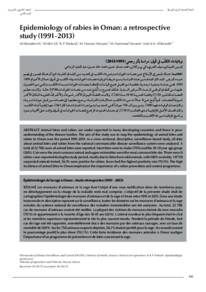Document
Epidemiology of rabies in Oman: a retrospective study (1991–2013).
Identifier
DOI: 10.26719/2015.21.8.591
Contributors
Al-Abri, SA., Author
Prakash, K. P., Author
Hassan Hussain, M., Author
Hammad Hussain, M., Author
Al-Rawahi , A. H., Author
Other titles
وبائية داء الكلَب في عُمان : دراسة بأثر رجعي (1991-2013)
Publisher
World Health Organization.
Gregorian
2015-08
Language
English
Subject
English abstract
Animal bites and rabies are under-reported in many developing countries and there is poor understanding of the disease burden. The aim of this study was to map the epidemiology of animal bites and rabies in Oman over the period 1991–2013. In a cross-sectional, descriptive, surveillance-based study, all data about animal bites and rabies from the national communicable disease surveillance system were analysed. A total of 22 788 cases of animal bites were reported. Most bites were to males (70%) and the 10–19 year age group (26%). Cats were the most common animal and upper extremities were the most common bite site. There were 8 rabies cases reported during the study period, mostly due to bites from wild animals, with 100% mortality. Of 758 suspected animals tested, 56.1% were positive for rabies; foxes had the highest positivity rate (70.1%). The high incidence of animal bites in Oman emphasizes the importance of a rabies prevention and control programme.
Member of
ISSN
1020-3397
Resource URL
Arabic abstract
هناك نقص في الإبلاغ عن عضات الحيوانات وعن داء الكلب في العديد من البلدان النامية، كما أن هناك قصور في فهم عبء المرض. لقد كان الهدف من هذه الدراسة رسم خريطة لوبائية عضات الحيوانات وداء الكلب في عُمان خلال الأعوام 1991-2013. ففي دراسة وصفية ترصدية مقطعية تم تحليل جميع البيانات المتعلقة بعضات الحيوانات وبداء الكلب، والتي تم الحصول عليها من النظام الوطني لترصد الأمراض السارية. فكان مجموع ما أُبلغ عنه من عضات الحيوانات 22788 حالة. وكانت معظم العضات للذكور (70 %) وللفئة العمرية 10-19 سنة (26 %). وكانت القطة الحيوانَ الأكثر شيوعاً، والأطرافُ العلوية المكانَ الأكثر شيوعاً للعضات. كما أُبلغ عن 8 حالات من داء الكلب خلال فترة الدراسة، يرجع معظمها إلى عضات من قبل حيوانات برية، وكان معدل الوفيات فيها 100 %. ومن بين الـ 758 حيواناً التي اشتبه بها وتم إجراء اختبارات لها كان 56.1 % منها إيجابياً لداء الكلب. وكان المعدل الأعلى للإيجابية لدى الثعالب (70.1 %). إن معدل الحدوث المرتفع لعضات الحيوانات في عُمان يؤكد على أهمية وجود برنامج للوقاية من داء الكلب ومكافحته
Category
Journal articles

